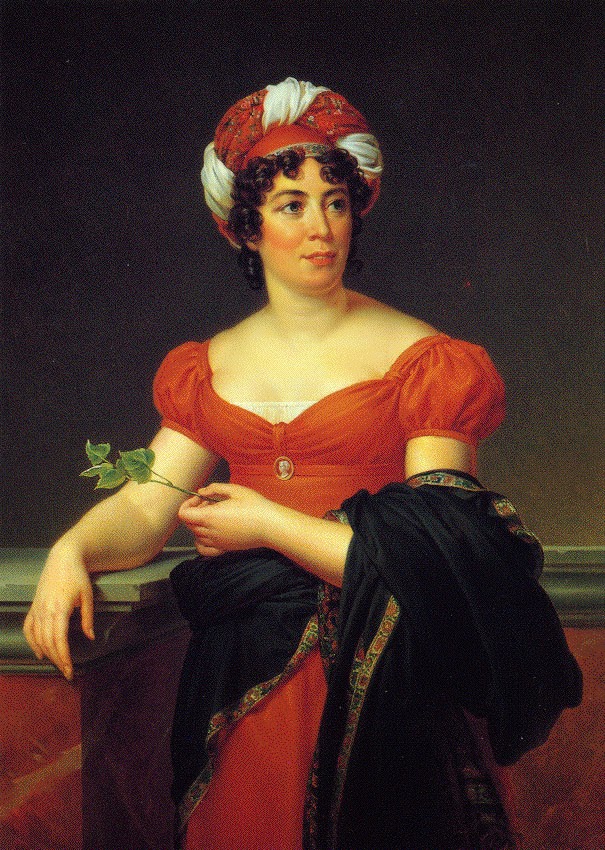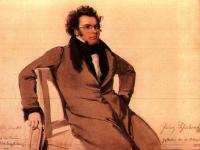
Madame de Staël (1766-1817)
On July 14, 1817, French woman of letters of Swiss origin Anne Louise Germaine de Staël-Holstein, commonly known as Madame de Staël, passed away. She was one of Napoleon’s principal opponents. Celebrated for her conversational eloquence, she participated actively in the political and intellectual life of her times. Her works, both critical and fictional, made their mark on the history of European Romanticism. She was a remarkable woman, and not all men of her time did really well get along with her. Most notable examples are Napoleon, Goethe, or Schiller.
Anna Louise Germaine Necker
Anne Louise Germaine Necker was born on April 22, 1766, in Paris, France as the only daughter of the prominent Swiss banker and statesman Jacques Necker,[4] who was the Director of Finance under King Louis XVI of France. Her mother was Suzanne Curchod, hostess of one of the most popular salons of Paris, who intended to educate her daughter according the principles of J.-J. Rousseau [6] and to endow her with the intellectual education and Calvinist discipline of her own Protestant pastor father. She usually brought Germaine as a young child to sit at her feet in her salon, where the sober intellectuals took pleasure in stimulating the brilliant child. After Jacques Necker’s dismissal from office, they resided in 1784 in Coppet at Château, her father’s estate on Lake Geneva, which she later would make famous.
Madame de Staël – A Woman of Extravagance
Soon Germaine’s parents became impatient for her to marry. But, the difficulty now in France was that they are said to have objected to her marrying a Roman Catholic, which definitely limited the number of available candidates. Finally, she married Baron Erik Magnus Staël von Holstein in 1786, who was first an attaché of the Swedish legation, and then minister. The husband was 37, the wife 20. Madame de Staël was accused of extravagance. This was a mere legal formality, however, and on the whole the marriage seems to have been acceptable to both parties, neither of whom had any affection for the other. Overall, de Staël was striking rather than beautiful with a flamboyant style of dress. She is described as being tall, but rather clumsy. Actually, there is the story where she tripped over her train when she made her debut at court and fell on her face. She had abundant black hair, large hazel eyes, beautiful shoulders, and a generous bosom. While not a great beauty, she was vivacious and more important, a witty conversationalist, not afraid to share her opinions.
Literary Criticism and Revolution
She began writing novels strongly supporting the ideals of Rousseau and favored constitutionalism in politics. Her novels were bestsellers and her literary criticism was highly influential. Her first child, a boy, was born in 1790 the week before Necker finally left France in unpopularity and disgrace; and the increasing disturbances of the Revolution made her privileges as ambassadress very important safeguards. She fled the September massacres in 1792, and then moved to Coppet Castle, where she gathered round her a considerable number of friends and fellow-refugees, the beginning of the salon which at intervals during the next 25 years made the place so famous.
Napoleon Bonaparte
It was during these years that Madame de Staël was of chief political importance. And it was also the time that she became regarded by contemporary Europe as the personal enemy of Napoleon Bonaparte. It displeased Napoleon that Madame de Staël should show herself recalcitrant to his influence. But it probably pleased Madame de Staël to quite an equal degree that Napoleon should apparently put forth his power to crush her and fail. Both personages had a curious touch of theatricality.
“Madame,” the general informed the lady in question, “I do not want women mixed up in politics.” “You are perfectly right,” came the reply, “but in a country where their heads are cut off, it is only natural for them to want to know why.” (Exchange between Napoleon Bonaparte and Madame de Staël.)
She formed the nucleus of a liberal resistance that so embarrassed Napoleon that in 1803 he had her banished to a distance of 64km from Paris.
Travels through Europe
From December 1803 to April 1804 she made a journey through Germany, culminating in a visit to Weimar, already established as the shrine of Johann Wolfgang von Goethe [7] and Friedrich von Schiller.[8] In Berlin she met August Wilhelm von Schlegel,[6] who was to become, after 1804, her frequent companion and counselor. Meanwhile Madame de Staël, persecuted by the police, fled from Napoleon’s Europe. Having married a young Swiss officer, “John” Rocca in 1811, she went to Austria and, after visiting Russia, Finland, and Sweden, arrived in England in 1813.
Lord Byron
She was received with enthusiasm, although reproached by such liberals as Lord Byron [9] for being more anti-Napoleonic than liberal. On the Bourbon Restoration in 1814, Madame de Staël returned to Paris but was deeply disillusioned: the fall of Napoleon had been followed by foreign occupation and had in no way reestablished liberty in France. During the Hundred Days she escaped to Coppet and in September 1815 set out again for Italy. She went back to Paris and demonstratively joined the new king, Louis XVIII. In gratitude, she was reimbursed by him for the two million francs that his older brother, Louis XVI, had borrowed from her father during the revolutionary period. In 1816 she returned to spend the summer at Coppet, where she was joined by Lord Byron, in flight from England after his unhappy matrimonial experience. A strong friendship developed between the two writers.
Final Years
Also in 1816, she married her daughter Albertine to Duke Achille-Léon-Victor de Broglie in Pisa, thus becoming the progenitor of a series of important French figures of that name. In February 1817, at the age of barely 51, she suffered a stroke in Paris that left her paralyzed on one side and caused her death in July of the same year.
Helena Rosenblatt, “Benjamin Constant, Germaine de Staël, and the Foundations of Liberalism”, [10]
References and Further Reading:
- [1] Germaine de Stael at Britannica Online
- [2] Mme de Stael at Biographies in Context
- [3] Napoleon’s Women: The Life of Madame de Stael
- [4] Jacques Necker and the Finances of France, SciHi Blog
- [5] “Man was born free, and he is everywhere in chains” – Jean-Jacques Rousseau, SciHi Blog
- [6] August Wilhelm Schlegel and his Shakespeare Translations, SciHi Blog
- [7] The Life and Works of Johann Wolfgang von Goethe, SciHi Blog
- [8] ‘Art is the Daughter of Freedom’ – Friedrich Schiller, SciHi Blog
- [9] Wicked Lord Byron’s Wonderful Poetry, SciHi Blog
- [10] Helena Rosenblatt, “Benjamin Constant, Germaine de Staël, and the Foundations of Liberalism”, Yan P. Lin Centre, McGill University @ youtube
- [11] Bordoni, Silvia (2005) Lord Byron and Germaine de Staël, The University of Nottingham
- [12] Germaine de Stael at Wikidata
- [13] Works by or about Germaine de Staël at Internet Archive
- [14] Saintsbury, George (1911). “Staël, Madame de“. In Chisholm, Hugh (ed.). Encyclopædia Britannica. Vol. 25 (11th ed.). Cambridge University Press. pp. 750–752.
- [15] Timeline of Women Literary Critics, via DBpedia and Wikidata





